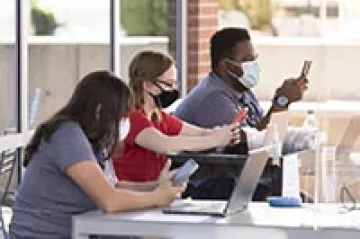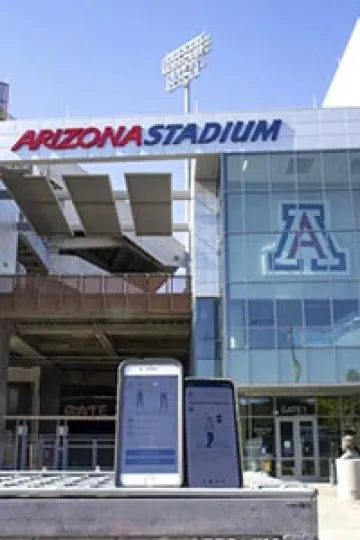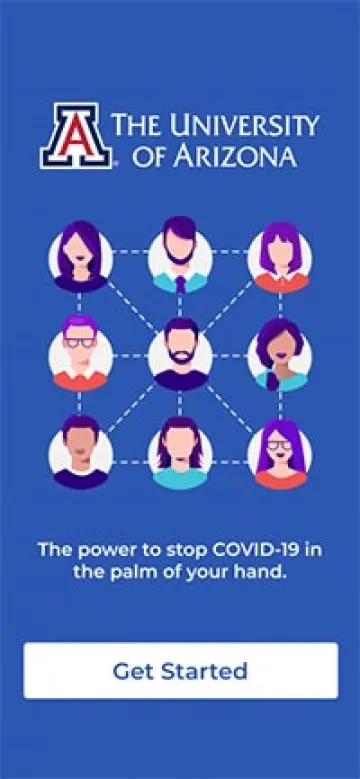UArizona and Covid Watch Launch COVID-19 Exposure Notification App
University of Arizona students, faculty and staff can now download and opt in to the Covid Watchexposure notification smartphone app, which allows users who have been diagnosed with COVID-19 to anonymously notify others who may have been exposed. After a successful pilot, the goal is for the app to be used statewide.
While other apps provide personal data like location or contact information to central authorities, such as a state or an institution,

Covid Watch is one of the first fully anonymous exposure alert apps deployed in the United States, and the only one able to integrate all available information about an exposure to produce the most accurate possible assessment of risk.
The app is a vital part of our plan to mitigate the risk of COVID-19 as we return to campus over the coming weeks with our on-ramp approach said University of Arizona President Robbins C. Robbins, MD. I am very proud of our partnership with Covid Watch, which allows us to prioritize privacy while using this incredible technology for exposure alerts. I hope our entire campus community takes advantage of this resource. The more people who use it, the safer we will be
The university's Campus Reentry Task Force, directed by 17th U.S. Surgeon General Richard Carmona, MD, MPH, a distinguished professor at the UArizona Mel and Enid Zuckerman College of Public Health, is continuously working on plans to mitigate risk on campus, including an effort to test, trace and treat students and employees. That effort also includes antibody testing and diagnostic testing, as well as traditional contact tracing.

UArizona has partnered with the nonprofit organization Covid Watch, which was co-founded by a University of Arizona alumna, to lead efforts to customize the exposure notification app and ready it for use on campus and across the state.
Campus community members are encouraged to download the app. Once they do, they will be prompted to select the University of Arizona as their region. The number of regions able to securely confirm diagnoses will grow after the pilot. Users will then be offered region-specific information and resources upon notification of exposure risk. For example, exposed UArizona users will be told whether to quarantine and for how long, what symptoms to monitor, how to reach a UArizona manual contact tracer and how to connect with Campus Health to schedule a test or be seen for symptoms.
Every step has been customized for University of Arizona users said Joyce Schroeder, PhD, head of the UArizona Department of Molecular and Cellular Biology, who is leading development of the app for UArizona with Covid Watch.
I encourage everyone to download this because we live in a community Dr. Schroeder said. If our community doesnt attain and maintain a reasonably low level of transmission, then we cant begin to get back to normal. We have to attack the virus as a society. Everyone needs to do their part
Smart & Private Technology
Founded by Stanford University and the University of Waterloo researchers in February, Covid Watch first developed the novel technology to send exposure alerts without having to collect any personally identifying information from users.
The app is able to calculate a person's level of exposure risk by assessing duration of exposure to an infected person, distance from an infected person and the point in the infection arc at which a user was exposed, said Joanna Masel, DPhil, a professor in the UArizona Department of Ecology and Evolutionary Biology. She and her team developed the risk assessment technology and their findings are posted on the preprint server Medrxiv.
Once installed, the app generates random codes while logging anonymous codes from other nearby Covid Watch apps. These anonymized codes are exchanged via Bluetooth signals.
To prevent false alarms, users who test positive for COVID-19 must input a verification code from a lab, doctor or medical center. At the University of Arizona, this code will come from Campus Health. The app will then send an exposure notification alert to other Covid Watch users whose phones were registered as being near the infected patient's phone.

Were the only app that truly integrates all information distance and time and timing about exposure to an infected person. Joanna has figured out a way to integrate the information to make for a more strategic exposure risk alert system to better reflect real life Dr. Schroeder said.
While not mandatory for the University of Arizona community, the app offers an opportunity for people to help prevent the spread of COVID-19 by alerting others directly and anonymously. Instead of informing a central authority of exposure status, the app works by informing people who are exposed directly using random codes exchanged by smartphone Bluetooth signals. This decentralized system preserves app users anonymity, so no central authority can track their personal data.
Weve been in conversations with members of the Centers for Disease Control and Prevention and the MIT Lincoln Laboratory, who are looking at all the different technologies that are out there, and how well they all work Dr. Schroeder said.
Other technologies to slow the spread of COVID-19 may rely on GPS to track interactions.
The problem with GPS is youre going to track someone's location, no question; that's how it works. The only technology that allows for you to be completely private and anonymous is low-energy Bluetooth Dr. Schroeder said.
The exposure alert technology used by Covid Watch is preferred by both the American Civil Liberties Union and the Electronic Frontier Foundation.
The whole team at Covid Watch is committed to helping the University of Arizona reopen safely said Covid Watch Executive Director Tina White, who graduated from UArizona in 2007 and 2009 with a bachelor's degree and then a master's degree in aerospace engineering. We will continue to collaborate on the development of our crowdsourced technology solution to provide the campus population with new tools to beat COVID-19 and hope to see other academic communities use this technology to better inform and care for each other
Instead of locking down everyone in the whole state, this technology lets us tell only the people at highest risk to quarantine Dr. Masel said. This is technology that is smart as well as private
It's always important to do what you can to protect yourselves and others from exposure, Schroeder added. This is just one mitigation method.
The best tool we have is definitely wearing a face mask Dr. Schroeder said. You can also do things like staying home as much as possible and getting tested if you have been in contact with a positive person. Otherwise, you could potentially become a silent spreader yourself. The more we spread, the less chance to return to normal. If we want to return to normal, then we have to work together
The UArizona Health Sciences COVID-19 Research webpage can be found here.
For the latest on the University of Arizona response to the novel coronavirus, visit the university's COVID-19 webpage.
For UANews coverage of COVID-19, visit https://uanews.arizona.edu/news/covid19.
# # #
This article appeared originally on the UA News website.
NOTE: Photos available upon request.
About the University of Arizona
The University of Arizona, a land-grant university with two independently accredited medical schools, is one of the nation's top public universities, according to U.S. News & World Report. Established in 1885, the university is widely recognized as a student-centric university and has been designated as a Hispanic Serving Institution by the U.S. Department of Education. The university ranked in the top 20 in 2018 in research expenditures among all public universities, according to the National Science Foundation, and is a leading Research 1 institution with $687 million in annual research expenditures. The university advances the frontiers of interdisciplinary scholarship and entrepreneurial partnerships as a member of the Association of American Universities, the 65 leading public and private research universities in the U.S. It benefits the state with an estimated economic impact of $4.1 billion annually. For more information: arizona.edu (Follow us: Facebook | Twitter | YouTube | LinkedIn | Instagram).

